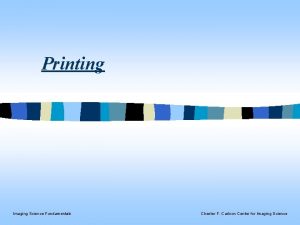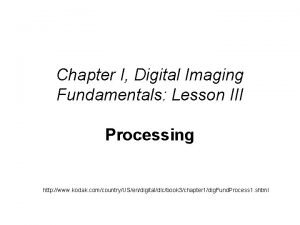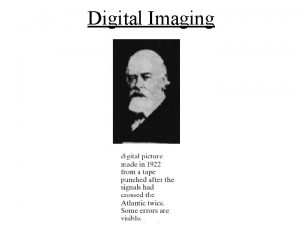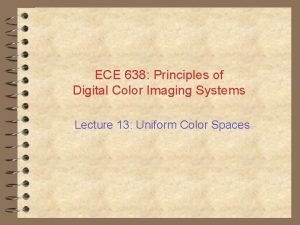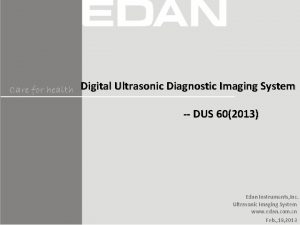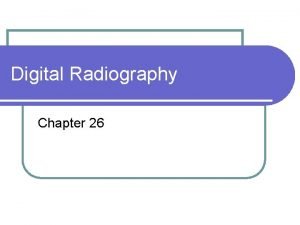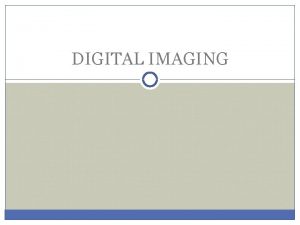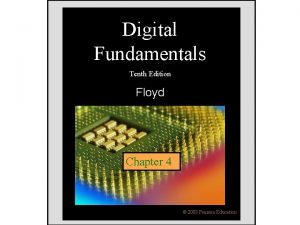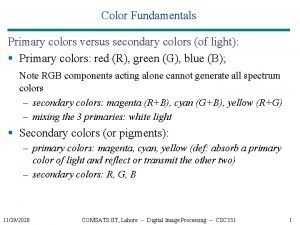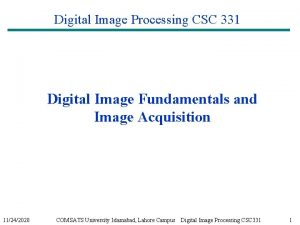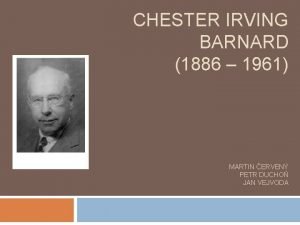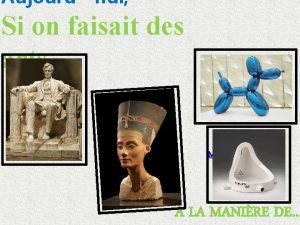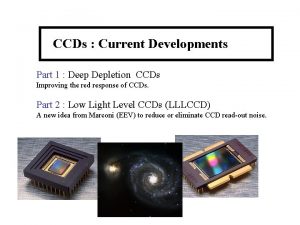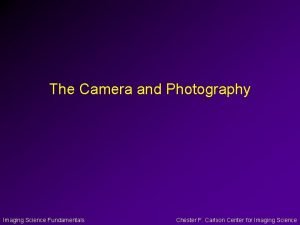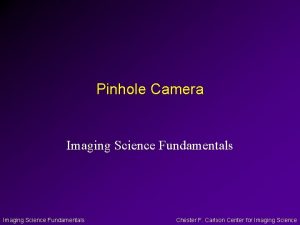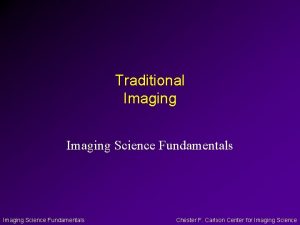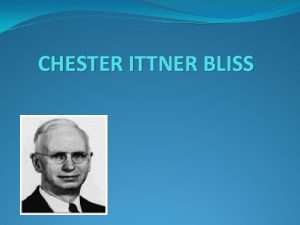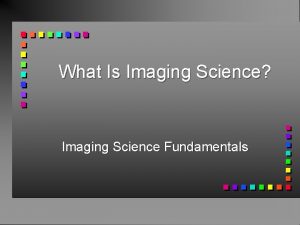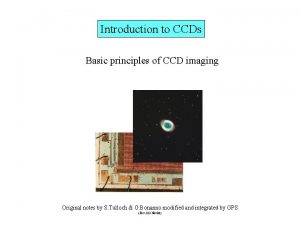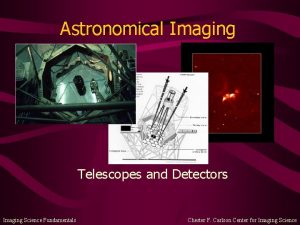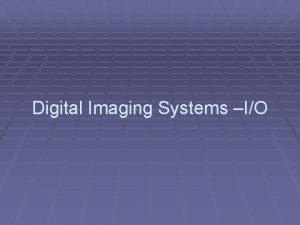Digital Imaging CCDs Imaging Science Fundamentals Chester F






















- Slides: 22

Digital Imaging: CCDs Imaging Science Fundamentals Chester F. Carlson Center for Imaging Science

Charge Coupled Device (CCD) u CCD replaces Ag. X film u Based on silicon chip u Disadvantages u Light Sensitive Area Imaging Science Fundamentals vs. Ag. X: Difficulty/cost of CCD manufacture; large arrays are VERY expensive u “Young” technology; rapidly changing Chester F. Carlson Center for Imaging Science

Response of CCD u The response of CCD is linear (i. e. , if 10, 000 captured photons corresponds to a digital count of 4, then 20, 000 photons captured yields a digital count of 8) Linearity is critical for scientific uses of CCD Density Response of photographic negative Log H Imaging Science Fundamentals Response of CCD Digital Count u Exposure Chester F. Carlson Center for Imaging Science

Spectral Response (sensitivity) of a typical CCD UV Visible Light IR Relative Response 300 400 500 600 700 800 900 1000 Incident Wavelength [nm] u Response is large in visible region, falls off for ultraviolet (UV) and infrared (IR) Imaging Science Fundamentals Chester F. Carlson Center for Imaging Science

Goal of CCD Photons CCD Electronic Signal u Capture electrons formed by interaction of photons with the silicon u Measure the electrons from each picture element as a voltage Imaging Science Fundamentals Chester F. Carlson Center for Imaging Science

Spatial Sampling Scene u u Grid over scene Spatially sampled scene When a continuous scene is imaged on the array (grid) formed by a CCD , the continuous image is divided into discrete elements. The picture elements (pixels) thus captured represent a spatially sampled version of the image. Imaging Science Fundamentals Chester F. Carlson Center for Imaging Science

Basic structure of CCD Divided into small elements called pixels (picture elements). Shift Register Image Capture Area Rows Voltageout Columns Imaging Science Fundamentals preamplifier Chester F. Carlson Center for Imaging Science

Magnified View of a CCD Array Individual pixel element CCD Close-up of a CCD Imaging Array Imaging Science Fundamentals Chester F. Carlson Center for Imaging Science

CCDs as Semiconductors Insulator u u u Conductors allow electricity to pass through. (Metals like copper and gold are conductors. ) Insulators do not allow electricity to pass through. (Plastic, wood, and paper are insulators. ) Some materials are halfway in between, and are called semiconductors. Imaging Science Fundamentals Chester F. Carlson Center for Imaging Science

Basic structure of a pixel in a CCD Metal gate Oxide Layer Silicon base One pixel u u u Silicon is a semiconductor. Oxide layer is an insulator. Metal gates are conductors. Made with microlithographic process. One pixel may be made up of two or more metal gates. Imaging Science Fundamentals Chester F. Carlson Center for Imaging Science

Photon/Silicon Interaction e- Silicon u Photon knocks off one of the electrons from the silicon matrix. Electron “wanders around” randomly through the matrix. u Electron gets absorbed into the silicon matrix after some period. u Imaging Science Fundamentals Chester F. Carlson Center for Imaging Science

Collection stage Voltage u u Voltage applied to the metal gates produces a depletion region in the silicon. (depleted of electrons) Depletion region is the “light sensitive” area where electrons formed from the photon interacting with the silicon base are collected. Imaging Science Fundamentals Chester F. Carlson Center for Imaging Science

Collection stage Voltage e- e- u Electron formed in the silicon matrix by a photon. u Electron wanders around the matrix. u If the electron wanders into the depletion region, the electron is captured, never recombining with the silicon matrix. Imaging Science Fundamentals Chester F. Carlson Center for Imaging Science

Collection Light e-e--e- ee- -- ee e u u e- e- e- The number of electrons accumulated is proportional to the amount of light that hit the pixel. There is a maximum number of electron that these “wells” can hold. Imaging Science Fundamentals Chester F. Carlson Center for Imaging Science

Readout u How do you access so much data efficiently? (i. e. a 1024 x 1024 CCD has 1, 048, 576 pixels!) u Possible u 1. solutions: Have output for individual pixels. u Too many “wires” u 2. Somehow move the charges across the CCD array and read out one by one. u Bucket Brigade Imaging Science Fundamentals Chester F. Carlson Center for Imaging Science

Bucket Brigade u By alternating the voltage applied to the metal gates, collected electrons may be moved across the columns. e-ee--e-e---ee- e-e-ee--eee--- ee--e- ee- - ee-e- e- e- ee ee e Imaging Science Fundamentals Chester F. Carlson Center for Imaging Science

Bucket Brigade u Charge is marched across the columns into the shift register, then read out 1 pixel at a time. 100 transfers 200 transfers Shift Register 100 pixels 100 transfers 1 transfer 100 pixels Imaging Science Fundamentals Chester F. Carlson Center for Imaging Science

Converting Analog Voltages to Digital u Analog voltage is converted to a digital count using an Analog-to-Digital Converter (ADC) u Also u The called a digitizer input voltage is quantized: u Assigned to one of a set of discrete steps Steps are labeled by integers u Number of steps determined by the number of available bits u u Decimal Integer is converted to a binary number for computation 6. 18 volts Imaging Science Fundamentals ADC 01100101 (117) Chester F. Carlson Center for Imaging Science

Bits and Bytes u u In the digital domain, there are only two possible numbers in a digit: 0 or 1. This numbering system is called a binary system. Each digit is called a bit (Binary dig. IT). Byte is 8 bits Decimal Binary 0 0 1 1 2 10 3 11 4 100 5 101 Imaging Science Fundamentals Chester F. Carlson Center for Imaging Science

Bits u Bits dictate how fine the quantization levels are. u An n bit system can represent 2 n numbers. 1 bit system = 21 = 2 levels (“Black” or “White”) 8 bit system = 28 = 256 levels 12 bit system = 212 = 4096 levels Imaging Science Fundamentals Chester F. Carlson Center for Imaging Science

Quantization ADC u Let’s say our 8 bit ADC accepts input voltage range of 0 to 10 v. u Since there are 256 discrete levels in an 8 bit system, each level will be 10 v/256 or 0. 0390625 volts per analog-todigital unit (ADU). So, if the input voltage was 6. 8 volts. . . Since ADU are stored as binary integers, the decimal must be truncated (to 174). Binary equivalent of 174 is 10101110. Volts DC 10 v 6. 8 volts 255 176 6. 8 v 175 174. 08 174 173 172 0 v 0 u u 6. 8 volts/0. 0390625 volts per DC = 174. 08 u Imaging Science Fundamentals Chester F. Carlson Center for Imaging Science

Quantization 0 0 0 0 0 Spatially sampled scene u 0 0 0 0 25 40 40 40 25 25 40 64 64 64 40 40 64 97 97 97 64 40 64 97 150 97 64 40 64 97 97 97 64 0 0 25 0 40 0 25 40 64 64 64 40 25 0 0 25 40 40 40 25 0 0 0 0 0 Numerical representation Spatially sampled image can now be turned into numbers according to the brightness of each pixel. Imaging Science Fundamentals Chester F. Carlson Center for Imaging Science
 Python
Python Fundamentals of digital imaging
Fundamentals of digital imaging Frc driver station mac
Frc driver station mac Digital imaging definition
Digital imaging definition Digital imaging artist
Digital imaging artist Digital color imaging
Digital color imaging Digital ultrasonic diagnostic imaging system
Digital ultrasonic diagnostic imaging system Chapter 39 digital imaging film and radiographs
Chapter 39 digital imaging film and radiographs Digital imaging terminology
Digital imaging terminology Chapter 39 digital imaging film and radiographs
Chapter 39 digital imaging film and radiographs What is your favourite subject?
What is your favourite subject? Digital fundamentals chapter 4
Digital fundamentals chapter 4 Floyd digital fundamentals 10th edition pdf
Floyd digital fundamentals 10th edition pdf Digital fundamentals by floyd 10th edition
Digital fundamentals by floyd 10th edition Color fundamentals in digital image processing
Color fundamentals in digital image processing Digital fundamentals floyd 10th edition
Digital fundamentals floyd 10th edition Digital fundamentals answers
Digital fundamentals answers Color
Color Abyasa chester
Abyasa chester Chester agricultural center
Chester agricultural center According to chester barnard an organization is
According to chester barnard an organization is Chester barnard
Chester barnard Daniel chester
Daniel chester
